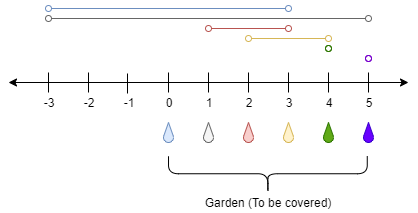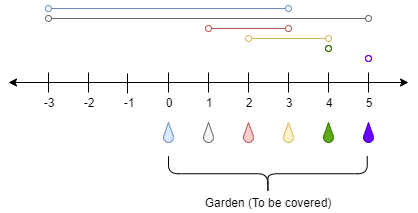[Swift]LeetCode1326. 灌溉花园的最少水龙头数目 | Minimum Number of Taps to Open to Water a Garden
★★★★★★★★★★★★★★★★★★★★★★★★★★★★★★★★★★★★★★★★
➤微信公众号:山青咏芝(let_us_code)
➤博主域名:https://www.zengqiang.org
➤GitHub地址:https://github.com/strengthen/LeetCode
➤原文地址:https://www.cnblogs.com/strengthen/p/12213419.html
➤如果链接不是山青咏芝的博客园地址,则可能是爬取作者的文章。
➤原文已修改更新!强烈建议点击原文地址阅读!支持作者!支持原创!
★★★★★★★★★★★★★★★★★★★★★★★★★★★★★★★★★★★★★★★★
There is a one-dimensional garden on the x-axis. The garden starts at the point 0 and ends at the point n. (i.e The length of the garden is n).
There are n + 1 taps located at points [0, 1, ..., n] in the garden.
Given an integer n and an integer array ranges of length n + 1 where ranges[i] (0-indexed) means the i-th tap can water the area [i - ranges[i], i + ranges[i]] if it was open.
Return the minimum number of taps that should be open to water the whole garden, If the garden cannot be watered return -1.
Example 1:

Input: n = 5, ranges = [3,4,1,1,0,0]
Output: 1
Explanation: The tap at point 0 can cover the interval [-3,3]
The tap at point 1 can cover the interval [-3,5]
The tap at point 2 can cover the interval [1,3]
The tap at point 3 can cover the interval [2,4]
The tap at point 4 can cover the interval [4,4]
The tap at point 5 can cover the interval [5,5]
Opening Only the second tap will water the whole garden [0,5]
Example 2:
Input: n = 3, ranges = [0,0,0,0]
Output: -1
Explanation: Even if you activate all the four taps you cannot water the whole garden.
Example 3:
Input: n = 7, ranges = [1,2,1,0,2,1,0,1]
Output: 3
Example 4:
Input: n = 8, ranges = [4,0,0,0,0,0,0,0,4]
Output: 2
Example 5:
Input: n = 8, ranges = [4,0,0,0,4,0,0,0,4]
Output: 1
Constraints:
1 <= n <= 10^4
ranges.length == n + 1
0 <= ranges[i] <= 100
在 x 轴上有一个一维的花园。花园长度为 n,从点 0 开始,到点 n 结束。
花园里总共有 n + 1 个水龙头,分别位于 [0, 1, ..., n] 。
给你一个整数 n 和一个长度为 n + 1 的整数数组 ranges ,其中 ranges[i] (下标从 0 开始)表示:如果打开点 i 处的水龙头,可以灌溉的区域为 [i - ranges[i], i + ranges[i]] 。
请你返回可以灌溉整个花园的 最少水龙头数目 。如果花园始终存在无法灌溉到的地方,请你返回 -1 。
示例 1:

输入:n = 5, ranges = [3,4,1,1,0,0]
输出:1
解释:
点 0 处的水龙头可以灌溉区间 [-3,3]
点 1 处的水龙头可以灌溉区间 [-3,5]
点 2 处的水龙头可以灌溉区间 [1,3]
点 3 处的水龙头可以灌溉区间 [2,4]
点 4 处的水龙头可以灌溉区间 [4,4]
点 5 处的水龙头可以灌溉区间 [5,5]
只需要打开点 1 处的水龙头即可灌溉整个花园 [0,5] 。
示例 2:
输入:n = 3, ranges = [0,0,0,0]
输出:-1
解释:即使打开所有水龙头,你也无法灌溉整个花园。
示例 3:
输入:n = 7, ranges = [1,2,1,0,2,1,0,1]
输出:3
示例 4:
输入:n = 8, ranges = [4,0,0,0,0,0,0,0,4]
输出:2
示例 5:
输入:n = 8, ranges = [4,0,0,0,4,0,0,0,4]
输出:1
提示:
1 <= n <= 10^4
ranges.length == n + 1
0 <= ranges[i] <= 100
1 class Solution { 2 func minTaps(_ n: Int, _ ranges: [Int]) -> Int { 3 var rg:[[Int]] = [[Int]](repeating: [Int](repeating: 0, count: 2), count: n + 1) 4 for i in 0...n 5 { 6 let s:Int = i - ranges[i] 7 let e:Int = i + ranges[i] 8 rg[i] = [s < 0 ? 0 : s, e < n ? e : n] 9 } 10 rg = rg.sorted(by:{ 11 if $0[0] == $1[0] 12 { 13 return $0[1] < $1[1] 14 } 15 else 16 { 17 return $0[0] < $1[0] 18 } 19 } 20 ) 21 var ans:Int = 0 22 var i:Int = 0 23 var start:Int = 0 24 var end:Int = 0 25 while(start < n && i <= n) 26 { 27 while(i <= n && rg[i][0] <= start) 28 { 29 end = max(end, rg[i][1]) 30 i += 1 31 } 32 if end <= start{return -1} 33 start = end 34 ans += 1 35 } 36 return ans 37 } 38 }


 浙公网安备 33010602011771号
浙公网安备 33010602011771号